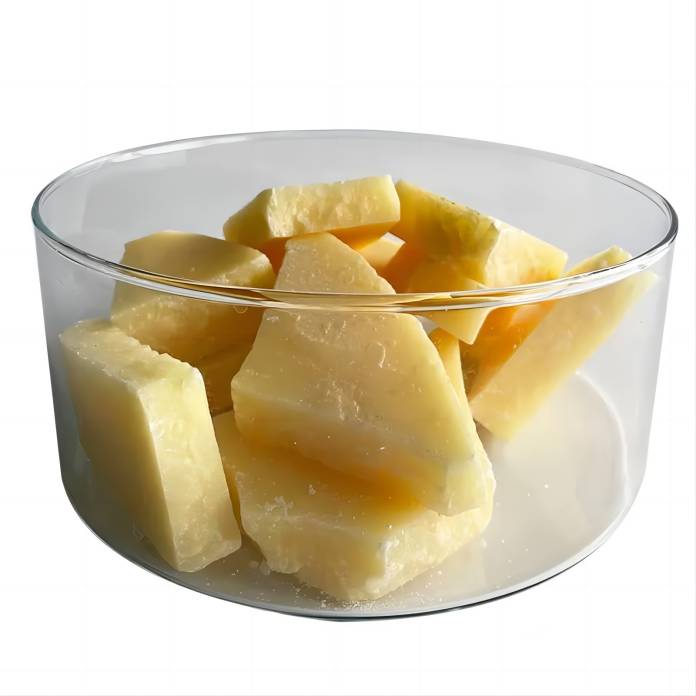Everything You Need to Know About Oryza Sativa Rice Bran Wax
What is Oryza Sativa Rice Bran Wax?
Oryza sativa rice bran wax also called rice bran wax, is the waste of rice bran oil processing by refining the product[1-3], by many kinds of different carbon chain length fatty alcohol and fatty acid combination and becoming the ester mixture, rice bran wax molecular carbon chain length distribution range is C44 ~ C62, rice bran wax fat alcohol molecular weight is 430 ~ 460, fatty acid molecular weight is 340 ~ 360[4-6]. The research on the composition of rice bran wax began in the twentieth century in the twentieth generation, and with the application of chromatographic separation technology in lipid analysis, there was a big breakthrough in the seventies. Japan Iwama, Takamoto and Rock (Tulloch) and so on successively analyzed the carbon number composition of alcohol and acid homologue in rice bran wax, carried out the determination of carbon number, and made people have a clearer understanding of the composition of rice bran wax[7-9].
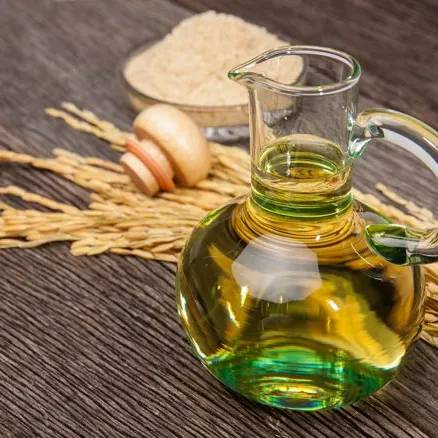
1.Physical Properties of Oryza Sativa Rice Bran Wax
Refined rice bran wax is a white or light yellow solid, the specific gravity of rice bran wax is 0.97 in the solid state at room temperature, its expansion coefficient is 0.00064 in the liquid state at room temperature, and 0.00111 in the solid state; rice bran wax has a certain hardness, and the melting point is higher (78~83℃), and there is no viscosity. The gloss of rice bran wax is very good and it has electrical insulation properties. At room temperature, the solubility of oryza sativa rice bran wax in organic solvents is very low, at 20℃, the solubility in petroleum ether, six solvents and toluene is 1.0%~3.5%, and the solubility in methanol, isopropyl alcohol, 95% ethanol, butanol, hexane, acetone, and benzene is even lower, only 0.1%~0.86%. Meanwhile, the solubility gradually increases with increasing temperature [10-13].
2. Chemical Properties of Oryza Sativa Rice Bran Wax
Rice bran wax is an ester mixture mainly composed of higher fatty acids and higher monohydric alcohols (also containing trace amounts of hydrocarbon compounds). The saponification value of rice bran wax is usually 72-80; The iodine value is relatively low, between 17 and 20; The acid value is 1-4; The content of unsaponifiable substances in rice bran wax is 54-60%; The acetyl value of rice bran wax is 3-5. In addition, rice bran wax, as an ester, can be hydrolyzed, but it is difficult and can only be carried out in alkaline media. Its hydrolysis process is slower and more difficult than that of oil, and it cannot be completely decomposed in acidic media [14-17].
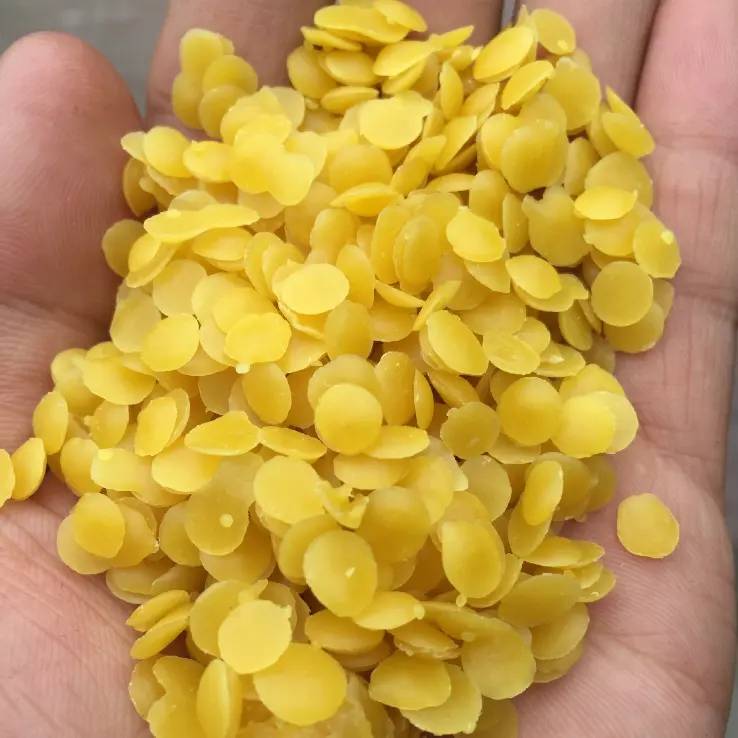
3. Melting Point of Rice Bran Wax
Rice bran wax is a light yellow lump. Slightly rice bran odor. Melting point 60~85℃. Can be mutually soluble with all kinds of natural wax arbitrarily. Insoluble in water, insoluble in ethanol, hot soluble in xylene and trichloroethylene, benzene, and other organic solvents.
4. Oryza Sativa Rice Bran Wax Composition
Oryza sativa rice bran wax is different from Brazilian carnauba wax and beeswax in that it contains double esters, triple esters, and diol esters, etc. Its composition is relatively single, with most of the wax esters composed of even-carbon number long-chain fatty acids and even-carbon number long-chain aliphatic monobasic primary alcohols, and relatively few other components [18-19]. Due to the differences in the processing methods of rice bran wax, the composition of the wax is inconclusive, and there are many studies on its composition in China and abroad, but there is no uniform conclusion [20-23].
Wang Yun et al. analyzed the composition of fatty acids and fatty alcohols in rice bran waxes of different origins by gas chromatography and concluded that the carbon number of fatty acids in bran waxes ranges from C14 to C36, which is much longer than that of fatty acids in general animal and vegetable fats and oils. Among them, even carbons account for about 95%, C22 and C24 fatty acids are the main fatty acids, and the sum of these two fatty acids accounts for about 60%. And contains a small amount of unsaturated fatty acids, among them are C18 monoolefin, diene and trienoic acid as, its content with the rice bran wax refining degree to improve and reduce. In the crude rice bran wax, the total content of C18:1, C18:2 and C18:3 is as high as 28-61%, which is mainly due to the high oil content in the crude rice bran wax and the high content of oleic acid and linoleic acid in the rice bran oil. The fatty alcohol carbon number distribution range of rice bran wax is C22-C38, even carbon alcohol accounts for about 95%, and the content of thirty alcohol is the highest. Fatty acid carbon number distribution range is C14-C36, even carbonic acid accounts for about 95%, and C24 acid content is the highest, accounting for more than 40% [24-25].
5. Oryza Sativa Rice Bran Wax Manufacturing Method
1) Taking wax oil as raw material, adopt a saponification method, wax oil first by bagging presses, remove most of the oil and grease, obtain the gross wax, then carry on the saponification of the gross wax, washes, dehydrate, then decolors the treatment to obtain the fine bran wax. The advantage of this method is simple production equipment, and low investment; shortcomings are also obvious, labor intensity, and low wax yield. At the same time because of the wax with neutral oil saponification, resulting in more soap and washing liquid, easy to cause environmental pollution.
2) Take wax oil or wax as raw material and adopt the solvent extraction method. This method improves the rate of oryza sativa rice bran wax and its oil use value, improves the labor conditions, and prevents and reduces the pollution to the environment; However, the required production equipment investment is large.
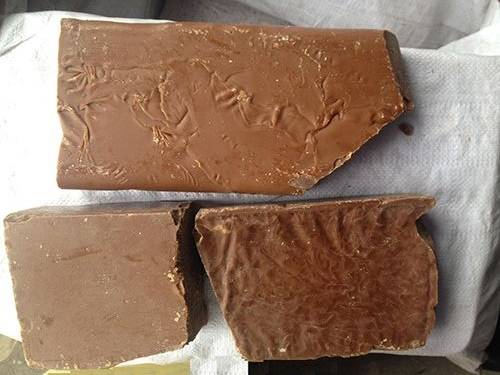
6. Application of Oryza Sativa Rice Bran Wax
Rice bran wax can be used as a substitute for Brazilian carnauba wax in most applications due to its relatively high melting point. It is used in paper coatings, textiles, explosives, fruit and vegetable coatings, confectionery, pharmaceuticals, candles, molded novelties, electrical insulation, textile and leather sizing, waterproofing, copy paper, typewriter ribbons, printing inks, lubricants, crayons, adhesives, chewing gum and cosmetics.
In cosmetics, oryza sativa rice bran wax is used as an emollient and is the base material for some exfoliating particles. It has been found that at concentrations as low as 1% triglyceride, rice bran wax can crystallize to form a stable gel.
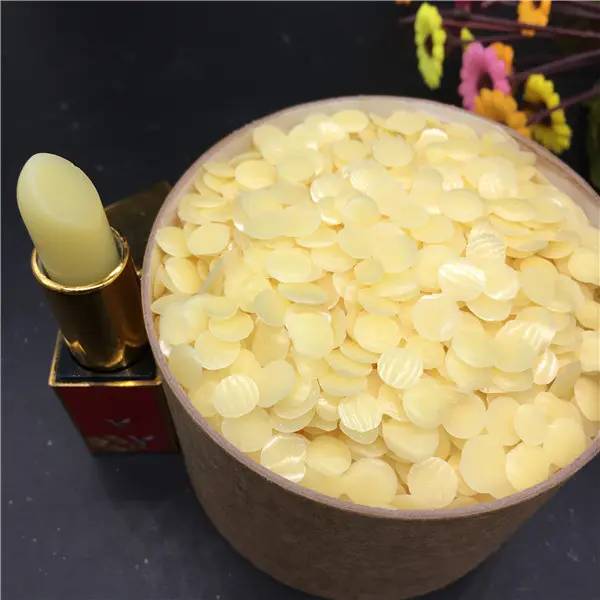
Reference:
[1] Li Guihua, Qian Xiangming. Research on the Production Process of Refined Furfury Wax[j] . Chinese Journal of Cereals and Oils, 2003 , 18(5):58-61.
[2] Li Guihua, Fu Limin, Liu Dafu Et Al. Refining and Compositional Analysis of Bran Wax[j] . Grain and Oil, 2000, 21(7):2-6.
[3] Zhang Ziming. Extraction of Bran Wax[J]. China Oil and Fats, 1988 ,(3):49-50.
[4] Xu Renbo. Preparation and Development of Rice Bran Wax[j]. Grain and Fats, 2005,(4):35-37.
[5]Luo Xiaolan, Zhu Wenxin. Purification and Comprehensive Utilization of Rice Bran Wax[j] . Grain and Oil Processing, 2007, (7):84-86.
[6] Chai, Ben-Wang. Dewaxing of Rice Bran Oil[j]. Grain, Oil and Food Science and Technology, 2000, 8(6):5-7.
[7] Wang Zhongli. Development and Application of Deep Processing Products of Rice Bran in Foreign Countries[j] . China Rice, 2005 ,(3):49-51.
[8] Chen Fang, Hui Bo-Di, Zhu Lei Et Al. Study on Factors Affecting the Extraction of High-Carbon Fatty Alcohols from Furfury Wax by Ester Exchange Reaction[j]. China Journal of Cereals and Oils, 2003 , 18(2):75-78.
[9] Chen F. Extraction and Refining of Eicosanoids from Rice Bran and Research on Its Anti-Fatigue Function[d] . Beijing: China Agricultural University, 2003.
[10] L.Rajam, D.R. .Soban Kumar, A.Sundaresan, C .Arumughan. A novel process for physically refining rice bran oil through simultaneous degumming and dewaxing[J].Journal of the American Oil Chemists'Society, 2005, 82(3)
[11] Li Xiang. Comparison of Utilization of Rice Bran in China and Japan[j]. Grain Storage, 2004 ,(2):48-52.
[12] Zeng Yikun, Huang Xiujuan, Zhao Meifeng. Discussion on the Production Process of Furfury Wax Prepared with Isopropyl Alcohol as Solvent[j] . Journal of Wuhan Institute of Technology, 2000 ,(4):21-23.
[13] Li Yun-Ming, Liang Shao-Hua, Wu Zhong-Ying. Refining of Rice Bran Oil and Technology of Bran Wax Production[j] . China Oil & Fats, 2006, 31(7):33-35.
[14]B.K.De, D.K.Bhattacharyya.Physical refining of rice bran oil in relation to degumming and dewaxing[J].Journal of the American Oil Chemists' Society, 1998,75(11):1683-1686.
[15]G.Haraldsson.Degumming, dewaxing and refining[J].Journal of the American Oil Chemists’ Society ,1983,(2):251-256.
[16]M.S.Kuk, M.K.Dowd.Supercritical CO2 extraction of rice bran[J].Journal of the American Oil Chemists' Society,1998,75 (5):623-628.
[17] Liu Yuanfa, Wang Xingguo, Yang Lin. Application of Ultrasound in the Hydrolysis of Rice Bran Wax[j]. Chinese Journal of Cereals and Oils, 2003, 58 18(5):62-64.
[18]Martini.S,M.C. .Anon.Crystallization of Sunflower Oil Waxes[J].Journal of the American Oil Chemists' Society,2003, 80:525–532.
[19]Martini.S ,M.C.Anon,Determination of Wax Concentration in Sunflower Seed Oil[J].Journal of the American Oil Chemists'Society, 2000, 77:1087–1092.
[20]Yoon.S.H ,J.S.Rhee.Composition of Waxes from Crude Rice Bran Oil[J] .Journal of the American Oil Chemists'Society,1982,59(12):561–563.
[21]Warth Albin Henry.The chemistry and technology of waxes[M].New York: New York Reinhold Pub,1947:332.
[22]P.Ramakrishna,K.V.L.Venkatesh ,T.C.Poornima.Effect of Wax Content on Flow Properties of Rice Bran 0il[J]. Journal of the American Oil Chemists' Society,1987,64(6):859–861.
[23]Mahua Ghosh , Sibdas Bandyopadhyay.Studies on the Crystal Growth of Rice Bran Waxin a Hexane Medium[J].Journal of the American Oil Chemists'Society,2005,82(4):229–231.
[24] Xu Renpu. Study on the Production of High Purity Eicosanol from Rice Bran Wax[j] . Grain and Oil, 2002 ,(9):4-5.
[25] Wang Yun, Egg Hong-Sun, Ni Pei-De. Compositional Analysis of Rice Bran Wax[j]. China Oil and Fats, 1998 ,23(6):39-41.
-
Prev
Do You Know A New Process For Efficient Extraction Of High Purity Centella Asiatica Glycosides?
-
Next
How to Make Rice Bran Wax: An Efficient Method


 English
English French
French Spanish
Spanish Russian
Russian Korean
Korean Japanese
Japanese